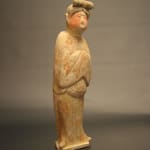Tang Dynasty Painted Terracotta Fat Lady, 618 CE - 907 CE
Painted Terracotta
height 30.5 cm
height 12 in
height 12 in
DL.2075
Further images
During the Tang Dynasty, restrictions were placed on the number of objects that could be included in tombs, an amount determined by an individual's social rank. In spite of the...
During the Tang Dynasty, restrictions were placed on the number of objects that could be included in tombs, an amount determined by an individual's social rank. In spite of the limitations, a striking variety of tomb furnishings, known as mingqi, have been excavated. Entire retinues of ceramic figures - animals, entertainers, musicians, guardians - were buried with the dead in order to provide for the afterlife. Of the various types of mingqi, there is perhaps none more charming than the beautiful sculptures of elegant female courtiers, sometimes known as “Fat Ladies” for their fleshy faces. These gorgeous women reflect the appreciation of the female form during the Tang Dynasty.
This sophisticated woman provided eternal companionship for her lord throughout the afterlife. We can imagine her gracefully dancing or singing a poetical song, two popular customs for ladies during the Tang Dynasty. Such courtiers are described in the numerous love poems written during this era, considered a golden age of Chinese culture. She has her hair styled in a sophisticated coiffure that crown her heads while she wears an elegant long-sleeved robe typical of the time period. A remarkable amount of the original pigment that once decorated the work remains intact, most noticeable on the floral motifs that decorate the dress as well as her rosy cheeks and lips. Such women may represent wives, princesses, or attendants. Her beauty inspires us as we are transported back to another time. This gorgeous sculpture has been to the next world and returned to our modern era to tell us her tale. They speak of the enormous wealth and sophisticated culture of the Tang Dynasty, one of the greatest periods of artistic creation in human history.
This sophisticated woman provided eternal companionship for her lord throughout the afterlife. We can imagine her gracefully dancing or singing a poetical song, two popular customs for ladies during the Tang Dynasty. Such courtiers are described in the numerous love poems written during this era, considered a golden age of Chinese culture. She has her hair styled in a sophisticated coiffure that crown her heads while she wears an elegant long-sleeved robe typical of the time period. A remarkable amount of the original pigment that once decorated the work remains intact, most noticeable on the floral motifs that decorate the dress as well as her rosy cheeks and lips. Such women may represent wives, princesses, or attendants. Her beauty inspires us as we are transported back to another time. This gorgeous sculpture has been to the next world and returned to our modern era to tell us her tale. They speak of the enormous wealth and sophisticated culture of the Tang Dynasty, one of the greatest periods of artistic creation in human history.





